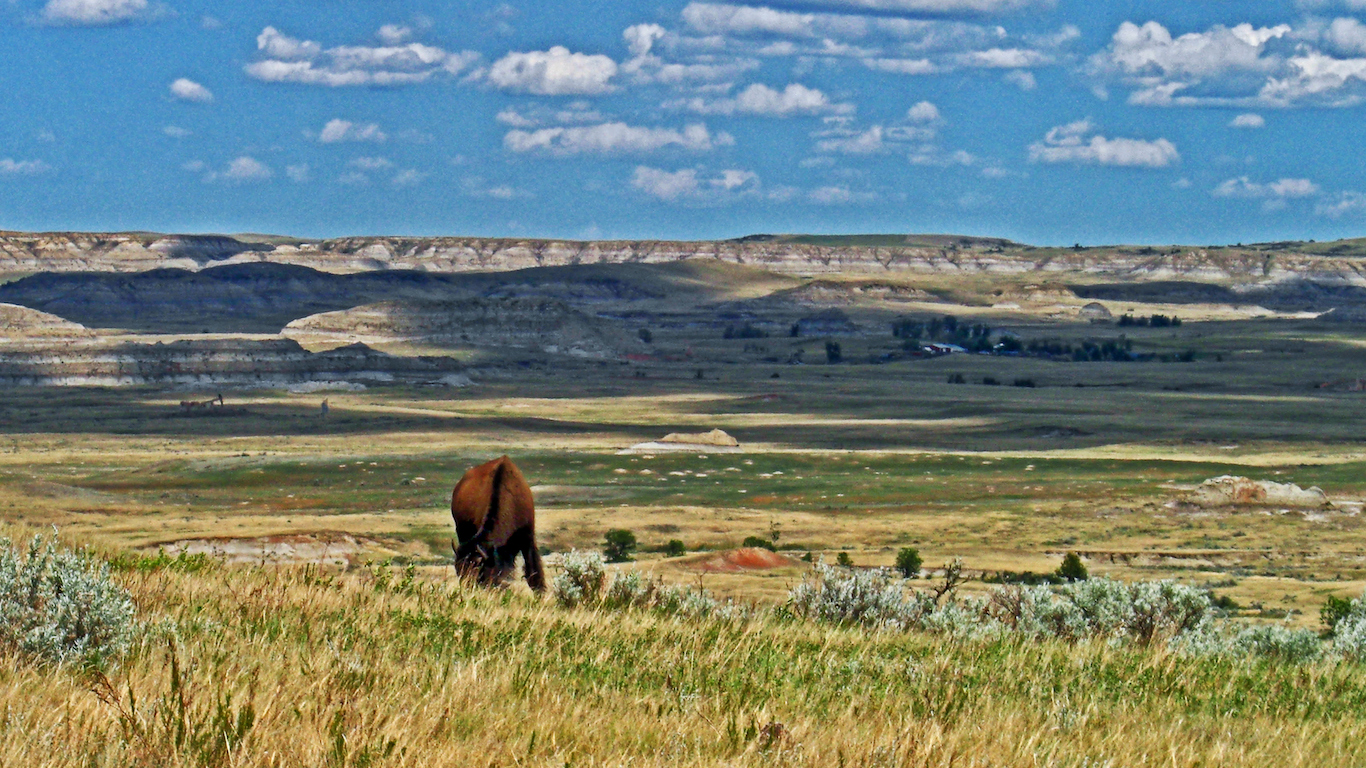Special Report
The Most (and Least) Healthy States: A Survey of All 50

Published:
Last Updated:

Progress in a society can be measured by steady improvement in health outcomes. The United States has made progress in some health areas over the years. Other health issues, however, have proven more challenging and some have even worsened considerably. Health outcomes differ widely across states, and the likelihood of living a healthy life largely depends on where you live, according to the latest report from the United Health Foundation.
To provide a more complete picture of where the country is succeeding and where it is failing, the United Health Foundation’s 2016 America’s Health Rankings report examined both determinants and health outcomes. The UHF included such factors as healthy behaviors, quality of health care, health policy, the incidence of diseases, and preventable deaths across the nation. Each of these areas varies considerably between states. This year, Hawaii is once again the healthiest, while Mississippi is the least healthy state in the nation.
[in-text-ad]
Across the nation, due to policy and awareness, the smoking rate fell from 29.5% in 1990 to 17.5% last year, and immunization rates for children and adolescents have increased. However, obesity and drug-related fatalities have risen dramatically. Close to 30% of the U.S. adult population is obese, up considerably from 1990 when just 11.6% of adults were obese. Also, there were approximately 47,000 drug overdose deaths last year, or 14 for every 100,000 people, up from 8.5 per 100,000 five years ago.
Click here to see the most (and least) healthy states.
In an interview with 24/7 Wall St., Dr. Reed Tuckson, external clinical advisor to the UHF, said that a variety of complex factors can explain poor health and the resulting untimely deaths in a given state. Likewise, states typically do well in some health measures and poorly in others. In general, however, “States that are socioeconomically better off do better in the rankings than states that are poor,” Tuckson said.
Of the 25 states on the lower end of the UHF ranking, 18 have poverty rates that exceed the national rate of 14.7%. This is the case in only four of the nation’s 25 healthier states.
Few metrics are more closely-tied to health than education. In 16 of the 25 states on the higher end of the UHF ranking, college attainment rates exceed the national rate of 30.6%. This is the case in only three of the nation’s 25 less-healthy states.
People do not necessarily learn healthy habits at college, but a bachelor’s degree helps provide a greater sense of control over one’s life as Tuckson noted. Because individuals with college degrees tend to earn higher incomes, they also tend to live in wealthier communities. “People who are living in [these] higher socioeconomic environments have more resources available to support them in their personal choices,” Tuckson said.
While health status can potentially be predicted by socioeconomic factors, health is also largely determined by individual behavior. Residents of the nation’s healthiest states are much more likely to report healthy behaviors than residents living in the least healthy states. For example, the percentage of adults who do not take time to exercise outside of work is higher than the national percentage of 26.2% in just six of the 25 states at the top of the health ranking. Meanwhile, physical inactivity is relatively more common in 17 of the 25 less-healthy states.
Tuckson added that while it is by no means easy to overcome social and economic disadvantages, “These are decisions people are making about their lives, these are things that are within the control of the individual.”
By prioritizing public health, elected and other public officials can also make a major difference in the health of a state’s population. Governments are responsible for mobilizing a state’s assets, and poor fiscal management can result in budget cuts to health services. Whether residents of states have the benefit of high health insurance coverage or a good immunization record is largely the consequence of policy decisions and community organizations.
Based on data provided by United Health Foundation’s America’s Health Rankings, 24/7 Wall St. reviewed all 50 states based on their overall scores. The UHF based its ranking on a number of measures that fall into two separate categories: health determinants and health outcomes. Determinants were further divided into behaviors, such as smoking and drinking; community and environmental factors, such as children living in poverty; policy factors, such as public health funding and immunization rates; and clinical care factors, such as the availability of doctors and dentists. Outcomes included rates of death from cancer and cardiovascular diseases, the incidence of diabetes and infectious diseases, as well as infant mortality rates.
These are the nation’s most and least healthy states.

1. Hawaii
> Pct. obese: 22.7% (2nd lowest)
> Cardiovascular deaths per 100,000 people: 206.6 (4th lowest)
> Primary care physicians per 100,000 people: 172.6 (10th highest)
> Uninsured rate: 4.7% (3rd lowest)
Residents of Hawaii are the healthiest of any state residents for the fifth year in a row. Hawaii excels in a number of health measures. Of particular note is the state’s health insurance system. The state enacted in 1974 the Hawaii Prepaid Health Care Act which required employers to provide health insurance to employees who work at least 20 hours per week. With the legislation, Hawaii became the nation’s first state to boast near-universal health care system. Currently fewer than 5% of residents do not have health insurance, nearly the best health insurance coverage of any state. Further, the rate of preventable hospitalizations per year in Hawaii, at 23.5 per 1,000 people, is the lowest of all states and less than half the national rate of 50 per 1,000 Americans.
[in-text-ad]
Hawaiians are also more likely than residents in other states to report healthy behaviors. Just 14.1% of adults report a smoking habit, for example, the eighth lowest share of all states.

2. Massachusetts
> Pct. obese: 24.3% (5th lowest)
> Cardiovascular deaths per 100,000 people: 205.6 (3rd lowest)
> Primary care physicians per 100,000 people: 227.5 (2nd highest)
> Uninsured rate: 3.1% (the lowest)
While healthy habits are not necessarily learned in college, people who have attained higher education tend to earn higher incomes and make healthier choices. College-educated Americans also tend to live in higher socioeconomic environments, where greater resources are often available to support healthier behaviors. With the nation’s most educated population, these factors are likely at play in Massachusetts, the second healthiest state. Over 40% of adults have at least a bachelor’s degree in the state, considerably higher than the national rate of a little over 30%.
Those with a college degree report considerably lower smoking and obesity rates compared with adults who have less education. Like several of the nation’s healthiest states, Massachusetts’ smoking rate of 14.0% and obesity rate of 24.3% are among the lowest of all states.

3. Connecticut
> Pct. obese: 25.3% (9th lowest)
> Cardiovascular deaths per 100,000 people: 217.2 (10th lowest)
> Primary care physicians per 100,000 people: 197.8 (4th highest)
> Uninsured rate: 6.5% (7th lowest)
A high income makes a world of difference in the health of American families. A variety of complex factors explain the link between income and health. For example, higher income Americans tend to make healthier choices, and tend to live in wealthy communities with greater resources available to support healthier lifestyles. Connecticut’s median household income of $71,346 a year is among the highest of all states. Unlike most other top 10 states, however, this income is not especially well distributed in Connecticut. Based on the Gini coefficient, income is more poorly distributed in the state than in every other state except for New York. Connecticut residents also report relatively health behaviors. For example, the state’s smoking rate of 13.5% is fourth lowest of all states and well below the national smoking rate of 17.5%.

4. Minnesota
> Pct. obese: 26.1% (12th lowest)
> Cardiovascular deaths per 100,000 people: 188.2 (the lowest)
> Primary care physicians per 100,000 people: 159.3 (14th highest)
> Uninsured rate: 5.2% (4th lowest)
Minnesota’s poverty rate of just 10.2% is tied for fourth lowest in the country. Nearly 35% of the population has a bachelor’s degree, among the higher shares of U.S. states. The typical Minnesota household earns $63,488 a year, far more than the national median income of $55,775. Relative affluence, a lack of poverty, and higher educational attainment together have far-reaching consequences on the state’s health outcomes. Educated residents with a steady income are more likely to have the resources needed to afford healthy lifestyle choices and are more likely to make decisions in the interest of long-term health. Minnesota has among the lowest rates of adults reporting poor mental or physical distress. The state also has below average incidence of several negative health outcomes, including the lowest rate of premature death in the country. An estimated 5,369 years are lost to residents dying of preventable causes per 100,000 residents, the lowest of all states and much lower than the national rate of 7,054 lost years per 100,000 residents.

5. Vermont
> Pct. obese: 25.1% (8th lowest)
> Cardiovascular deaths per 100,000 people: 226.9 (15th lowest)
> Primary care physicians per 100,000 people: 173.0 (9th highest)
> Uninsured rate: 4.4% (2nd lowest)
Vermont has always been a leader in health insurance coverage and at one point was set to implement a universal payer system. The plan was abandoned in 2014, but the state still manages a health insurance exchange and expanded Medicaid under the ACA. Just 4.4% of state residents lack health insurance, second lowest share in the country after Massachusetts. An insured population is more likely to receive treatment when needed, is more likely to engage in preventative medicine, and also will not suffer from the stress of being at risk of financial catastrophe in case of an unexpected medical emergency. Vermont has one of the highest rates of immunization in a number of categories. The state also has one of the lowest rates of premature death of any state.

6. New Hampshire
> Pct. obese: 26.3% (13th lowest)
> Cardiovascular deaths per 100,000 people: 213.9 (8th lowest)
> Primary care physicians per 100,000 people: 157.4 (15th highest)
> Uninsured rate: 7.8% (16th lowest)
Across almost every major category of health determinants and outcomes, New Hampshire ranks among the top in the country. A full 60% of residents report they are in very good or excellent health, the highest share in the nation. The self-reported health mirrors New Hampshire’s health outcomes, as the state has below average rates of obesity, premature death, and most major life-threatening illnesses.
[in-text-ad]
The state has one of the highest median household incomes and the lowest poverty rate in the country. In addition to the benefits associated with economic prosperity, the state likely owes its positive outcomes to a number of healthy practices, including very high immunization rates as well as below average rates of physical inactivity, and smoking.

7. Washington
> Pct. obese: 26.4% (14th lowest)
> Cardiovascular deaths per 100,000 people: 213.3 (6th lowest)
> Primary care physicians per 100,000 people: 141.4 (20th highest)
> Uninsured rate: 7.9% (19th lowest)
Washington residents report some of the healthiest behaviors in the country. Just 19.0% of adults do not engage in physical activity outside of work, far less than the national inactivity rate of 26.2%. Washington’s population has a relatively healthy diet, with adults consuming 1.4 fruits and 2.1 vegetables a day on average. While obesity is a rising problem across the country, obesity remains relatively low in the state at 26.4% of all adults.
Communities with healthy-behaving residents also tend to prioritize health care, and Washington has some of the best health care infrastructure in the country. Just 6.4% of all newborns have low birthweight, and roughly 33 in 1,000 patients are hospitalized for conditions that are treatable outside of the hospital — each the fifth smallest share of any state. There are also 73 dentists for every 100,000 residents, about 12 more than the national dentist-to-population ratio.

8. Utah
> Pct. obese: 24.5% (6th lowest)
> Cardiovascular deaths per 100,000 people: 225.0 (14th lowest)
> Primary care physicians per 100,000 people: 96.7 (2nd lowest)
> Uninsured rate: 11.5% (16th highest)
Utah residents have among the healthiest behavior of any state population. Just 12.4% of Utah adults engage in excessive drinking, and just 9.1% smoke, the third and lowest percentages respectively of all states. Abstaining from unhealthy habits has likely helped keep diseases at bay and lower premature death incidence among the Utah population. In a given year, there are approximately 150 cancer deaths per 100,000 Utah residents, the lowest incidence of any state.
While Utahns have some of the healthiest behaviors in the country, the state’s health policy infrastructure is among the weakest. The state’s children are not properly vaccinated for a range of diseases, and just 82% of adolescents are immunized against tetanus, diphtheria, and pertussis. An estimated 32 cases of pertussis, or whooping cough, are reported out of every 100,000 Utah residents annually, a higher proportion than all but two other states.

9. New Jersey
> Pct. obese: 25.6% (10th lowest)
> Cardiovascular deaths per 100,000 people: 245.4 (25th highest)
> Primary care physicians per 100,000 people: 165.2 (12th highest)
> Uninsured rate: 9.8% (25th highest)
New Jersey residents are among the least likely to report certain unhealthy habits. Only 13.5% of adults are smokers, one of the lowest smoking rates in the country and well below the 17.5% share of American adults. Garden State lawmakers likely have a hand in lowering the smoking rate as cigarette taxes in New Jersey are among the highest in the country. In addition, only 25.6% of adults in New Jersey are obese, well below the 29.8% national obesity rate.
With many unhealthy behaviors less prevalent than in the country as a whole, New Jersey residents are more likely to live to be at least 75 years old. Premature death is less common in New Jersey than in all but five other states.

10. Colorado
> Pct. obese: 20.2% (the lowest)
> Cardiovascular deaths per 100,000 people: 199.3 (2nd lowest)
> Primary care physicians per 100,000 people: 136.3 (25th highest)
> Uninsured rate: 9.2% (23rd lowest)
While healthy habits are not necessarily learned in college, individuals who have attained higher education tend to have a greater sense of control over their lives — and partially as a result report better health outcomes. With one of the nation’s most educated state populations, Colorado, which is among the top 10 healthiest states this year, is likely a case in point. Nearly 40% of Colorado adults have at least a bachelor’s degree, second only to Massachusetts. College educated Americans also tend to live in higher socioeconomic environments where greater resources are often available to support healthier choices. In Colorado, these resources include access to parks and other exercise venues. More than a quarter of Americans report getting no exercise other than getting up and going to work in the morning. In Colorado, by contrast, only 17.9% of adults report such sedentary lifestyles, the lowest such percentage of any state.

11. North Dakota
> Pct. obese: 31.0% (17th highest)
> Cardiovascular deaths per 100,000 people: 231.4 (21st lowest)
> Primary care physicians per 100,000 people: 136.3 (25th highest)
> Uninsured rate: 7.9% (19th lowest)
States with a high share of residents earning a steady income often report positive health outcomes, as these residents are more likely to have access to healthier lifestyle choices as well as medical care. North Dakota has the lowest unemployment rate in the country, as well as one of the lower poverty rates. The state also contributes substantially to residents’ health, having expanded Medicaid under the ACA. State residents report among the fewest days of poor mental or physical health in the country.
[in-text-ad]
The state’s record on some important health behaviors, as well as the associated health outcomes, is less than stellar. The state has above average rates of physical inactivity, smoking, and obesity. The state’s cardiovascular and premature death rates are similar to the nation.

12. Nebraska
> Pct. obese: 31.4% (14th highest)
> Cardiovascular deaths per 100,000 people: 227.0 (16th lowest)
> Primary care physicians per 100,000 people: 148.0 (19th highest)
> Uninsured rate: 9.0% (22nd lowest)
While drug overdoses have been on the rise nationwide, the problem is less acute in Nebraska. There are 7.1 drug overdose deaths per 100,000 state residents, roughly half the rate nationwide. While a relatively large share of Nebraska residents report some unhealthy behaviors and outcomes, such as binge drinking and obesity, in other measures the state reports relatively good outcomes. Fewer than one in 10 Nebraska adults report frequent mental or physical distress, for example, better than a majority of states.
Nebraska has a fairly effective health policy framework. A larger share of children have been properly vaccinated against HPV, tetanus, diphtheria, and pertussis than in a majority of states. Nebraska also has a fairly strong health care infrastructure, with more dentists and primary care physicians per capita than the country as a whole. It also reports a smaller share of infants born with low birthweight.

13. New York
> Pct. obese: 25.0% (7th lowest)
> Cardiovascular deaths per 100,000 people: 256.2 (18th highest)
> Primary care physicians per 100,000 people: 206.2 (3rd highest)
> Uninsured rate: 7.9% (19th lowest)
Likely due in large part to several positive socioeconomic measures, New York residents are healthier than Americans as a whole. Research shows that highly educated people have a greater sense of control over their lives and lead to longer, healthier lives. In New York, 35% of adults have at least a bachelor’s degree, a far larger share than the nationwide rate of 30.6% of American adults. Additionally, New York spends $154 on public health per capita, more than all but three other states.
Several positive health measures correlate as expected with high educational attainment and health spending. New York has the lowest suicide rate in the country and lower than average incidences of heart disease, high blood pressure, and infant mortality.

14. Rhode Island
> Pct. obese: 26.0% (11th lowest)
> Cardiovascular deaths per 100,000 people: 230.4 (20th lowest)
> Primary care physicians per 100,000 people: 247.7 (the highest)
> Uninsured rate: 6.6% (8th lowest)
High rates of immunization help lower the incidence of disease and are also an indication of a well-run state health system. With nation-leading immunization rates across multiple vaccination series, Rhode Island’s health policy is likely among the best. The immunization rates of meningococcal and tetanus for adolescents are each over 97%, considerably higher than the respective national percentages of 81.3% and 86.4%. A high ratio of doctors to residents is another feature of a strong health system. In Rhode Island, there are 247.7 primary care physicians for every 100,000 people, the highest ratio in the nation.

15. Idaho
> Pct. obese: 28.6% (18th lowest)
> Cardiovascular deaths per 100,000 people: 229.2 (18th lowest)
> Primary care physicians per 100,000 people: 93.7 (the lowest)
> Uninsured rate: 12.3% (11th highest)
The Idaho government contributes a fair amount to its residents’ health, spending $141.63 per resident on public health, fifth most of any state. However, somewhat unusual for a state spending so much, 12.3% of residents are uninsured, one of the higher shares in the country. The lower coverage is likely due in part to the state not expanding its Medicaid program under the ACA.
Healthy behavior is relatively common among state residents. The state has among the lowest shares of adults who get no exercise beyond getting up and going to work, and a low share of adults who smoke. Likely partially as a result, the state has below national rates of diabetes and cancer deaths and cardiovascular deaths.

16. California
> Pct. obese: 24.2% (4th lowest)
> Cardiovascular deaths per 100,000 people: 229.9 (19th lowest)
> Primary care physicians per 100,000 people: 131.5 (21st lowest)
> Uninsured rate: 10.5% (22nd highest)
The largest state in the country by population, health behaviors and outcomes vary considerably across California. The state reports relatively positive outcomes in some health measures but has considerable room for improvement in others. For example, Californians tend to be relatively physically active, and partially as a result, report a far lower than typical obesity rate. Only one in five California adults lead completely sedentary lives compared to more than one in four American adults. Likely partially as a result, only 24.2% of adults in the state are obese, one of the smallest shares in the country.
[in-text-ad]
Healthy behaviors and desirable outcomes in California appear to be largely limited to those with at least a high school education. No state has a larger gap in self reported health status between those with a high school education and those without than California.

17. Iowa
> Pct. obese: 32.1% (12th highest)
> Cardiovascular deaths per 100,000 people: 245.9 (24th highest)
> Primary care physicians per 100,000 people: 139.1 (23rd highest)
> Uninsured rate: 5.6% (5th lowest)
Certain unhealthy behaviors are considerably more common among adults in Iowa than they are nationwide, while other behaviors are far more scarce. For example, 21.0% of state adults drink excessively, a greater share than the 17.7% of American adults. However, drug abuse appears to be far less common in Iowa. About nine out of every 100,000 state residents die from drug use compared to 14 of every 100,000 Americans.
Iowans are also more likely than the average American to visit their doctor. The shares of adults in the state who check their cholesterol, visit the dentist annually, and receive colorectal cancer screening are slightly higher than corresponding national shares. This may be attributable to widespread insurance coverage. Only 5.6% of Iowans do not have insurance compared to 10.6% of uninsured Americans.

18. Maryland
> Pct. obese: 28.9% (20th lowest)
> Cardiovascular deaths per 100,000 people: 252.5 (20th highest)
> Primary care physicians per 100,000 people: 179.2 (8th highest)
> Uninsured rate: 7.3% (13th lowest)
Adults with higher educational attainment are more likely to have a greater sense of control over their life and to live longer, healthier lives. In Maryland, nearly 39% of adults have at least a bachelor’s degree, the third highest share of any state. With high educational attainment, Maryland residents are more likely than Americans as a whole to have a balanced diet and lead physically active lives.
Still, in many health measures, Maryland’s population has room for improvement. Close to 39% of adults in the state report getting inadequate sleep, nearly the largest share of any state in the country. Additionally, high blood pressure and diabetes are slightly more common among Maryland adults than among American adults.

19. Virginia
> Pct. obese: 29.2% (22nd lowest)
> Cardiovascular deaths per 100,000 people: 239.0 (25th lowest)
> Primary care physicians per 100,000 people: 138.1 (24th highest)
> Uninsured rate: 10.0% (23rd highest)
Virginia has one of the higher median household incomes and one of the highest shares of adults with a bachelor’s degree. Educational attainment is strongly tied to income, and both play a significant role in the health decisions and outcomes of a population. In terms of both behaviors and outcomes, Virginia’s record is somewhat mixed. The state has very low child immunization rates and higher incidences of certain life-threatening conditions such as high blood pressure. However, it has relatively low rates of heart attack and heart disease.

20. Wisconsin
> Pct. obese: 30.7% (19th highest)
> Cardiovascular deaths per 100,000 people: 236.8 (24th lowest)
> Primary care physicians per 100,000 people: 140.3 (21st highest)
> Uninsured rate: 6.5% (7th lowest)
Nearly one in four adults in Wisconsin engage in binge drinking, a larger share than any state other than North Dakota. While Wisconsin adults drink more than the average American, the state reports better health outcomes than most states. Just 8.4% of state adults have diabetes compared to 9.9% of adults nationwide. An estimated 6,324 years of life are lost to premature death in Wisconsin per 100,000 residents, about 700 less than the national figure.
Wisconsin spends just $42.70 on public health care per resident, less than half the average expenditure nationwide of $94.27 per American. Despite low health care spending, a larger share of Wisconsin adolescents are vaccinated against HPV, meningitis, diphtheria, tetanus, and pertussis than in a majority of states.

21. Oregon
> Pct. obese: 30.1% (22nd highest)
> Cardiovascular deaths per 100,000 people: 212.4 (5th lowest)
> Primary care physicians per 100,000 people: 139.6 (22nd highest)
> Uninsured rate: 8.4% (21st lowest)
Oregon’s adults are among the most likely in the country to make healthy choices. State residents smoke less, die from drug overdose less, and are very unlikely to live sedentary lifestyles. While the state’s outcome record is not perfect, it ranks among the best in the country in key measures such heart disease rate and preventable hospitalization.
[in-text-ad]
Still, despite the largely positive outcomes, Oregon’s adults, on average, are among the most likely to be in a state of poor physical or mental health. Oregonians are among the most likely to commit suicide.

22. Maine
> Pct. obese: 30.0% (24th highest)
> Cardiovascular deaths per 100,000 people: 220.8 (12th lowest)
> Primary care physicians per 100,000 people: 183.7 (7th highest)
> Uninsured rate: 9.3% (24th lowest)
Maine is the only state in New England that has not expanded Medicaid coverage under the ACA. Likely as a result, the state spends only about $85 per capita on public health, or $9 less than the average expenditure per American nationwide. Not surprisingly, it also has the highest uninsured rate in the New England at 9.3% of residents without health insurance.
Despite lower insurance coverage rates, 81% of adults in Maine have had their cholesterol checked recently, and 75% of state residents of appropriate age have had a recent colorectal cancer screening, both among the highest shares in the country.

23. Montana
> Pct. obese: 23.6% (3rd lowest)
> Cardiovascular deaths per 100,000 people: 227.3 (17th lowest)
> Primary care physicians per 100,000 people: 110.8 (7th lowest)
> Uninsured rate: 12.9% (9th highest)
The growing obesity epidemic in the United States is one of the greatest obstacles to health we face. Obesity is linked to many of the most common life-threatening conditions and illnesses, including heart disease, diabetes, high blood pressure, and cancer. Over the last decade and a half, the national obesity rate increased from 11.6% to almost 30%. In Montana, just 23.6% of the adult population is obese, the third lowest proportion in the country. Likely partially as a result, the state has among the lowest rates of heart attack, high blood pressure, and high cholesterol in the country.
In other measures, however, Montana has room for improvement. The state has very high rates of excessive drinking, low immunization rates, and the highest suicide rate in the country.

24. South Dakota
> Pct. obese: 30.4% (21st highest)
> Cardiovascular deaths per 100,000 people: 233.8 (22nd lowest)
> Primary care physicians per 100,000 people: 120.2 (12th lowest)
> Uninsured rate: 10.0% (23rd highest)
Pervasive unhealthy behaviors can have a considerable effect on the health outcomes of a population. Smoking, for example, is the leading cause of preventable death, and in South Dakota one in five adults smoke cigarettes, slightly more than the national smoking rate of 17.5%. A high smoking rate may have contributed to the state’s premature death rate, which is also slightly higher than the comparable national figure.
Other unhealthy habits and outcomes, however, are far less common in South Dakota than they are nationwide. Annually, there are 6.6 drug deaths for every 100,000 state residents, the second smallest share in the country and less than half the corresponding national rate. Additionally, adults in South Dakota report an average of only 2.4 mentally unhealthy days a month, the least of any state in the country.

25. Wyoming
> Pct. obese: 29.0% (21st lowest)
> Cardiovascular deaths per 100,000 people: 234.4 (23rd lowest)
> Primary care physicians per 100,000 people: 103.7 (4th lowest)
> Uninsured rate: 11.8% (15th highest)
Performing well in some measures of health but poorly in others, Wyoming falls in the middle of the nation’s health ranking. Incomes are relatively high in the state, for example, which helps ensure resources are available to support health care. The typical household in Wyoming earns $60,214 annually, higher than the comparable $55,775 national figure. On the other hand, while immunization rates across the nation have improved markedly in recent years, immunization rates remain very low in Wyoming. Further, the ratio of doctors to people in the state at 103.7 primary care physicians per 100,000 state residents is nearly the lowest of all states.

26. Illinois
> Pct. obese: 30.8% (18th highest)
> Cardiovascular deaths per 100,000 people: 253.8 (19th highest)
> Primary care physicians per 100,000 people: 169.5 (11th highest)
> Uninsured rate: 8.4% (21st lowest)
The health status of Illinois’ population is a mixture of positive and negative factors. For every 100,000 Illinois residents there are approximately 170 primary care physicians, for example, one of the highest concentrations of doctors in the nation. On the other hand, Illinois residents report some of the country’s highest alcohol abuse rates, with over 20% of adults binge drinking on a regular basis — fourth highest of all states.
[in-text-ad]
A state’s leadership also plays a role in the health of its population. Illinois operated without a budget of any kind for over a year due to political stalemate. While the impasse ended in July, major cuts were implemented during the crisis, including to health services. This year, Illinois ranks roughly in line with previous years’ rankings, but it remains to be seen how the state’s fiscal problems will affect future health outcomes.

27. Kansas
> Pct. obese: 34.2% (7th highest)
> Cardiovascular deaths per 100,000 people: 249.6 (22nd highest)
> Primary care physicians per 100,000 people: 129.0 (20th lowest)
> Uninsured rate: 9.7% (25th lowest)
One of the most severe health epidemics in America today is the rising prevalence of obesity. The problem is more acute in Kansas, where more than one in three adults are obese. In many other measures, the Kansas population is about as healthy as the American population overall. There are an estimated 193 cancer deaths and 250 cardiovascular deaths per 100,000 Kansas residents annually, about the same as the national figures.
The state’s health care infrastructure has little funding compared to the rest of the country. The state spends just $48.68 per resident on public health care, almost half the average health care expenditure of $94.27 per American nationwide. Low expenditures may be one reason for the low vaccination rates in the state. In addition to low HPV immunization rates, just 63.7% of adolescents are vaccinated against meningitis, nearly the lowest share in the country.

28. Pennsylvania
> Pct. obese: 30.0% (24th highest)
> Cardiovascular deaths per 100,000 people: 259.3 (16th highest)
> Primary care physicians per 100,000 people: 192.9 (5th highest)
> Uninsured rate: 7.5% (15th lowest)
While the effects of the opioid epidemic are felt in all states, Pennsylvania feels it more than most. There are about 20 drug deaths in the state for every 100,000 residents, far more than the national rate of 14 drug deaths per 100,000 Americans. Other negative health measures in the state include a higher than average smoking rate and a slightly smaller share of adults who are physically active.
While certain unhealthy behaviors contribute to negative health outcomes in the Keystone State, environmental circumstances also partially explain the state’s relatively low ranking. Due in large part to energy production in the state, Pennsylvania has the second worst air pollution in the country after only California.

29. Arizona
> Pct. obese: 28.4% (17th lowest)
> Cardiovascular deaths per 100,000 people: 213.7 (7th lowest)
> Primary care physicians per 100,000 people: 123.3 (14th lowest)
> Uninsured rate: 12.2% (13th highest)
Educational attainment is often an accurate predictor of health outcomes. In Arizona, the relationship is even stronger as the difference in self-reported health status of adults with a high school diploma and those without is far higher than average. Considering that only 77.4% of state adults have completed high school, one of the smallest such shares in the country, this discrepancy in health outcomes between those with and without high school education likely considerably adds to the state’s overall poor health outcomes.
Due in part to low educational attainment, 17.4% of people in Arizona live in poverty, one of the highest shares of any state. Poverty greatly limits people’s choices related to healthy food and safe neighborhoods. As a result, poverty can detract from both mental and physical health. State lawmakers could likely be doing more to help the neediest state residents. Despite expanding Medicaid in January 2014, Arizona still spends only about $42 per capita on public health, less than nearly every other state.

30. Alaska
> Pct. obese: 29.8% (25th lowest)
> Cardiovascular deaths per 100,000 people: 214.1 (9th lowest)
> Primary care physicians per 100,000 people: 134.1 (23rd lowest)
> Uninsured rate: 16.1% (2nd highest)
One of the wealthiest states in the country, the typical Alaskan household earns $73,355 a year. Unlike most high income states, Alaska struggles in a number of health measures. At 22.2 suicides a year for every 100,000 state residents, Alaska has the second highest suicide rate of any state. Additionally, the vaccination rates for meningitis, HPV, and pertussis among adolescents in the state are far lower than the national average rates.
Perhaps most glaring is the share of state residents without insurance coverage. Across the state, 16.1% of residents do not have health insurance, the second largest share in the country. The uninsured rate may not remain so high for long however. In mid-2015, the state expanded Medicaid coverage. The expansion will help uninsured residents who earn less than $20,000 a year.

31. Delaware
> Pct. obese: 29.7% (23rd lowest)
> Cardiovascular deaths per 100,000 people: 247.5 (23rd highest)
> Primary care physicians per 100,000 people: 151.4 (17th highest)
> Uninsured rate: 6.9% (9th lowest)
Some positive health measures in Delaware include above average rates of several important immunizations and lower binge and excessive drinking rates. However, on the whole, the state compares unfavorably to most states in a number of health indicators and outcomes. The average state resident is more likely than the average American to suffer from life-threatening illnesses such as heart disease, high blood pressure, and high cholesterol. An above average share of Delaware residents die of drug overdoses, and a higher share of adults than is typical gets little to no exercise besides getting up and going to work. The state has above average contraction rates of certain diseases, including chlamydia, pertussis, and salmonella. Delaware also has the eighth highest violent crime rate in the country. In addition to the victims of violent crime, residents of high crime areas can suffer from stress and other negative health effects.
[in-text-ad]

32. North Carolina
> Pct. obese: 30.1% (22nd highest)
> Cardiovascular deaths per 100,000 people: 251.9 (21st highest)
> Primary care physicians per 100,000 people: 128.3 (19th lowest)
> Uninsured rate: 12.2% (13th highest)
North Carolina has some of the worst health outcomes in the country. There are seven infant deaths per 1,000 live births, one of the highest infant mortality rates of any state. Additionally, 11.7% of adults report frequent mental distress, and 13.2% report frequent physical distress, larger shares than in most states. An indicator of poor health overall, there are 7,746 years of life lost to premature death in North Carolina per 100,000 residents, about 700 more than the annual average years of life lost per 100,000 Americans.
Despite pressure from federal officials, North Carolina is one of a minority of states that have not expanded Medicaid under the ACA. Partially as a result, public health spending in the state remains low at just $47.94 per resident, compared to the $94.27 spent on average nationwide.

33. Texas
> Pct. obese: 32.4% (10th highest)
> Cardiovascular deaths per 100,000 people: 256.9 (17th highest)
> Primary care physicians per 100,000 people: 110.3 (6th lowest)
> Uninsured rate: 18.1% (the highest)
Like just a minority of states, Texas did not expand Medicaid coverage under the ACA. Health care coverage in Texas remains the lowest in the country, with an estimated 18.1% of residents in the state lacking health insurance. The state’s clinical infrastructure is weaker than that of most states, with a high proportion of preventable hospitalizations and a low concentration of primary care physicians.
Texans have some of the least healthy behaviors of any state population. Nearly one in three adults in the state are obese, which may be partially due to the 29.5% of adults who engage in no physical activity outside of work, a larger share than the 26.2% national inactivity rate. Despite the poor health care and behavior, health outcomes are about the same as they are on average nationwide.

34. Michigan
> Pct. obese: 31.2% (16th highest)
> Cardiovascular deaths per 100,000 people: 288.7 (9th highest)
> Primary care physicians per 100,000 people: 187.5 (6th highest)
> Uninsured rate: 7.3% (13th lowest)
Drug overdoses are on the rise nationwide, and the health epidemic is particularly acute in Michigan. There are roughly 16 drug deaths per 100,000 Michigan residents, a higher rate than across the nation as whole. With an obesity rate of 31.2%, and a 20.7% smoking rate — each above the national rates — Michigan residents are less healthy than Americans nationwide.
An above average share of Michigan adults report feeling frequent mental and physical distress, and residents are more likely to die of cancer or heart disease than in a majority of states. An indication of poor health overall, an estimated 7,689 years of life are are lost to premature death per 100,000 Michigan residents, over 600 years more than the average years of life lost per 100,000 Americans annually.

35. Nevada
> Pct. obese: 26.7% (15th lowest)
> Cardiovascular deaths per 100,000 people: 277.8 (12th highest)
> Primary care physicians per 100,000 people: 104.3 (5th lowest)
> Uninsured rate: 13.8% (6th highest)
Nevada is one of the least healthy states in the country in terms of governance, community, and behaviors. In terms of spending, Nevada lawmakers allocate the equivalent of only $34 per resident on public health, the least of any state. Behaviorally, though residents are less likely to drink excessively and live sedentary lives than most Americans, they are not devoid of bad habits. There are 21 drug deaths for every 100,000 state residents, more than in all but six other states.
Safe communities are important for both physical and mental well-being, and Nevada is not an especially safe state. There are nearly 700 violent crimes, including rape and homicide, in Nevada for every 100,000 residents, more than in any state other than Alaska.

36. Florida
> Pct. obese: 26.8% (16th lowest)
> Cardiovascular deaths per 100,000 people: 224.8 (13th lowest)
> Primary care physicians per 100,000 people: 128.0 (18th lowest)
> Uninsured rate: 15.0% (3rd highest)
Florida’s 15.7% poverty rate is a full percentage point above the national poverty rate. A high poverty rate is indicative of a larger than average share of low income residents, who often have more difficulty accessing medical care. Since the state is one of 19 to not expand Medicaid coverage under the ACA, many low income residents in the state are likely left without insurance that could otherwise increase their access to preventative and diagnostic health care. Florida’s 15% uninsured rate is the third highest of all states.
[in-text-ad]
People with health insurance are more likely to regularly visit the doctor and address health issues before they become emergencies that require hospitalization. Florida has an above average rate of such preventable hospitalizations, which ultimately deplete hospital resources and expose patients to unnecessary health risks.

37. Missouri
> Pct. obese: 32.4% (10th highest)
> Cardiovascular deaths per 100,000 people: 283.6 (10th highest)
> Primary care physicians per 100,000 people: 155.9 (16th highest)
> Uninsured rate: 10.8% (19th highest)
In a number of health outcome measures, including incidence of heart disease, diabetes, and premature death, Missouri’s population is less healthy than the U.S. as a whole. State lawmakers could likely be doing more to improve the health of residents. Missouri spends only about $45 per capita on public health, nearly the lowest of all states and well below national per capita spending of $94. Low public health spending is partially due to Missouri being one of only 19 states to not expand Medicaid benefits under the ACA. Partially as a result, 10.8% of Missourians are without health insurance, a larger share than in the majority of states.

38. New Mexico
> Pct. obese: 28.8% (19th lowest)
> Cardiovascular deaths per 100,000 people: 217.5 (11th lowest)
> Primary care physicians per 100,000 people: 133.4 (22nd lowest)
> Uninsured rate: 12.7% (10th highest)
Poverty can greatly limit an individual’s ability to make healthy choices. In New Mexico, nearly 30% of children live in poverty, the highest share of any state in the country. The prevalence of poverty is partially attributable to low educational attainment. Only 69% of adults in the state have graduated high school, the smallest share of any state.
On an individual level, higher educational attainment can increase a sense of control over one’s life and lead to a longer and healthier life. Low educational attainment in New Mexico may partially explain several negative health behaviors. For every 100,000 state residents, 25 die from drug overdoses each year, the second highest share in the country. Adults in the state are also less likely to have had their cholesterol checked recently, to have been screened for colorectal cancer, or to regularly visit the dentist.

39. Indiana
> Pct. obese: 31.3% (15th highest)
> Cardiovascular deaths per 100,000 people: 277.1 (13th highest)
> Primary care physicians per 100,000 people: 121.3 (13th lowest)
> Uninsured rate: 10.8% (19th highest)
Indiana’s cancer and cardiovascular death rates are slightly higher than they are nationwide. Based on certain environmental conditions and behaviors in the state, respiratory illnesses may also be more common in Indiana than they are nationwide. Across the state, one in five adults smoke cigarettes, one of the larger smoking rates of any state. Additionally, Indiana’s air quality is relatively poor. Only three states have more air pollution than Indiana.
Obesity is associated with a number of chronic conditions, including heart disease and diabetes. In Indiana, 31.3% adults are obese, a higher share than the 29.8% national obesity rate. Obesity is likely partially attributable to physical inactivity in the state. More than 29% of Indiana adults get no physical exercise beyond getting up and going to work, greater than the 26% of share of American adults.

40. Ohio
> Pct. obese: 29.8% (25th lowest)
> Cardiovascular deaths per 100,000 people: 278.7 (11th highest)
> Primary care physicians per 100,000 people: 162.0 (13th highest)
> Uninsured rate: 7.5% (15th lowest)
While smoking rates nationwide have fallen in recent years, smoking likely remains a significant impediment to good health outcomes among Ohio’s adult population. Ohio is one of 13 states where more than one in five adults smoke cigarettes. Smoking is linked to a number of chronic conditions as well as early death, and Ohio has more years of life lost to premature death than all but a dozen other states.
Smoking is not the only bad habit cutting lives short in Ohio. Drug overdoses, from opioids in particular, contributed to the first increase in a decade in the nationwide death rate. In Ohio, the problem is especially pronounced. There were 21 drug deaths for every 100,000 state residents, far more than the rate nationwide of 14 drug deaths per 100,000 people.

41. Georgia
> Pct. obese: 30.7% (19th highest)
> Cardiovascular deaths per 100,000 people: 272.9 (15th highest)
> Primary care physicians per 100,000 people: 117.2 (10th lowest)
> Uninsured rate: 14.9% (4th highest)
Georgia trails the nation as a whole in a number of health measures. Insufficient sleep is associated with several chronic diseases, and Peach State residents are far more likely to be sleep deprived than Americans as a whole. Nearly 39% of adults in Georgia report getting fewer than seven hours of sleep a night on average, a larger share than in all but two other states. Additionally, though Georgia’s 30.7% obesity rate is lower than in many other states in the Southeast, it is slightly higher than the 29.8% national average rate. State residents also report higher than average incidences of diabetes and heart disease.
[in-text-ad]

42. South Carolina
> Pct. obese: 31.7% (13th highest)
> Cardiovascular deaths per 100,000 people: 274.1 (14th highest)
> Primary care physicians per 100,000 people: 124.3 (16th lowest)
> Uninsured rate: 12.3% (11th highest)
States that struggle with poverty tend to consistently report worse health outcomes. This is especially the case in the Southeastern United States. In South Carolina, which is among the 10 least healthy states, 16.6% of people live in poverty, the 11th highest share of all states. The incidence of infectious diseases such as chlamydia and salmonella is higher in South Carolina than in all but a handful of states, for example, and 11.8% of adults report having diabetes, the eighth highest share in the nation.
The relative frequency of illness in the state is underscored by a high uninsured rate. Across South Carolina, 12.3% of residents are without health insurance coverage, slightly higher than the 10.6% national uninsured rate.

43. West Virginia
> Pct. obese: 35.6% (2nd highest)
> Cardiovascular deaths per 100,000 people: 297.9 (7th highest)
> Primary care physicians per 100,000 people: 151.2 (18th highest)
> Uninsured rate: 7.3% (13th lowest)
In general, states with poorer residents tend to fall on the lower end of health rankings. West Virginia, with one of the nation’s highest poverty rates of 17.9%, remains one of the nation’s least healthy states. The state moved out of the worst five this year, however, an exceptionally strong improvement especially compared to other states struggling with poverty and other entrenched poor socioeconomic conditions.
One of the most alarming national trends observed recently has been the unprecedented rise in drug overdose deaths. The problem is especially pronounced in West Virginia, where there are 32.2 drug-related deaths per 100,000 people, the highest of all states.

44. Tennessee
> Pct. obese: 33.8% (9th highest)
> Cardiovascular deaths per 100,000 people: 302.7 (6th highest)
> Primary care physicians per 100,000 people: 135.1 (24th lowest)
> Uninsured rate: 11.2% (17th highest)
One of the most serious health problems facing the United States is rising obesity, and the related increased incidences of cardiovascular disease, diabetes, and premature death. The problem is especially pronounced in Tennessee, where 33.8% of the population is obese, the ninth highest rate of all states. Over 30% of state adults report getting no exercise whatsoever outside of getting up and going to work, the eighth highest level of physical inactivity of all states. This could partially explain the high obesity rate. Obesity and physical inactivity certainly do not help lower cardiovascular deaths in the state, which at over 300 per 100,000 people annually is one of the highest incidences in the nation.
The safety of a community can also have major health consequences for area residents. Tennessee’s poor health ranking is due in part to its high violent crime rate. At 612 reported incidents per 100,000 people, it is the fourth highest violent crime rate of all states.

45. Kentucky
> Pct. obese: 34.6% (5th highest)
> Cardiovascular deaths per 100,000 people: 297.8 (8th highest)
> Primary care physicians per 100,000 people: 117.7 (11th lowest)
> Uninsured rate: 7.3% (13th lowest)
Compared with college-educated Americans, the likelihood of adverse health outcomes is higher for adults with only a high school diploma and considerably higher for adults with less than high school education. There are a variety of complex factors that explain how education can lead to better health, including a greater sense of control over one’s life. The added opportunities that often lead to higher-paying jobs and the resources to support a healthy life are perhaps among the most beneficial. Conversely, low incomes in Kentucky likely help explain the poor health in the state. Just 23.3% of adults have at least a bachelor’s degree, the sixth lowest college attainment rate, and the median household income of $45,215 a year is among the lowest of all states.
A number of unhealthy behaviors are prevalent in Kentucky. For example, while smoking rates have fallen dramatically in the United States over the years, tobacco consumption remains relatively high in the Bluegrass State. Over 25% of adults smoke in the state, the highest adult smoking rate in the country.

46. Oklahoma
> Pct. obese: 33.9% (8th highest)
> Cardiovascular deaths per 100,000 people: 325.9 (3rd highest)
> Primary care physicians per 100,000 people: 123.7 (15th lowest)
> Uninsured rate: 14.7% (5th highest)
Socioeconomic conditions and environmental factors are major determinants of health. As Tuckson noted, however, while these factors can largely explain the health status of a state, people anywhere can take action and ultimately have control over their own lives and choices. Oklahoma reports a few exceptionally strong socioeconomic factors such as one of the nation’s lowest unemployment rates. But compared with most other states, Oklahomans do not report especially healthy behaviors. For example, adults in the state report nearly the lowest average daily fruit and vegetable intake of any state. The adult smoking rate in Oklahoma of 22.2% is also sixth highest nationwide.
[in-text-ad]
One of the most serious health problems facing the nation is drug abuse. The issue seems especially acute in Oklahoma, where in an average year over 20 drug-related deaths are reported for every 100,000 people, the seventh highest incidence of all states.

47. Alabama
> Pct. obese: 35.6% (2nd highest)
> Cardiovascular deaths per 100,000 people: 332.9 (2nd highest)
> Primary care physicians per 100,000 people: 116.4 (9th lowest)
> Uninsured rate: 11.1% (18th highest)
The national obesity rate has roughly tripled since 1990, when just 11.9% of adults were obese. Because obese individuals are at considerably greater risk of adverse health conditions such as heart disease and diabetes, many have tied the alarming obesity trend to rising cardiovascular deaths. The problem is especially pronounced in Alabama, where 35.6% of adults are obese, tied for the second highest rate with Mississippi, less than only Louisiana. Poor exercise rates help explain the problem in the state, as 31.9% of adults report getting no exercise whatsoever outside of getting up and going to work, the fifth highest level of physical inactivity. The incidence of cardiovascular death in Alabama of 332.9 per 100,000 people is second highest of all states, and the percentage of adults who have diabetes of 13.5% is third highest.

48. Arkansas
> Pct. obese: 34.5% (6th highest)
> Cardiovascular deaths per 100,000 people: 317.3 (4th highest)
> Primary care physicians per 100,000 people: 114.7 (8th lowest)
> Uninsured rate: 10.7% (21st highest)
Self-reported well-being is perhaps one of the best measurements of a person’s health status. A little over half of adults nationwide report being in either good or excellent health. In Arkansas, by contrast, just 42.3% of adults report being in such optimal health, the lowest percentage of all states. Similarly, the Arkansas residents report 4.7 poor mental health days in a given month on average, the most in the nation. The high level of poor health reported by state residents can be partially explained by unhealthy behaviors, which are relatively common in Arkansas. For example, 34.2% of adults report no exercise whatsoever outside of their job, and 24.9% smoke, the second and third highest percentages of all states, respectively.

49. Louisiana
> Pct. obese: 36.2% (the highest)
> Cardiovascular deaths per 100,000 people: 312.5 (5th highest)
> Primary care physicians per 100,000 people: 125.7 (17th lowest)
> Uninsured rate: 13.4% (8th highest)
Because of the difficulty of altering deeply entrenched socioeconomic environments, which strongly influence health outcomes, poor states routinely report the nation’s worst health outcomes. This trend is especially pronounced in Southeastern states like Louisiana, which was ranked least healthy in the nation last year. Louisiana, which still struggles with poverty, also struggles with a range of health issues, including low exercise rates and — partially as a consequence — the nation’s highest obesity rate. Nearly 20% of state residents live in poverty, the third highest rate of all states. Close to a third of adults report no exercise whatsoever outside of getting up and going to work everyday, the fifth highest such proportion in the country. Obesity in Louisiana mirrors the national epidemic but it is considerably worse there. Over 36% of adults in state are obese, the highest of all states.

50. Mississippi
> Pct. obese: 35.6% (2nd highest)
> Cardiovascular deaths per 100,000 people: 344.8 (the highest)
> Primary care physicians per 100,000 people: 102.3 (3rd lowest)
> Uninsured rate: 13.6% (7th highest)
Premature death is on the rise in the United States, and nowhere is the problem more pronounced than in Mississippi. The amount of life lost before age 75 each year for every 100,000 people in Mississippi is estimated at a staggering 10,804 years, the most of all states. A variety of complex factors can explain the poor health and resulting untimely deaths in the state. Few metrics are more closely tied to health than education, as a college degree helps provide a greater control over one’s life and increase the earning potential that can in turn afford access to resources that support healthier lifestyles. Just 20.8% of Mississippi adults have at least bachelor’s degree, the second lowest college attainment rate. Also, the state’s poverty rate of 22.0% is the highest in the nation.
The average American spends $17,274 on debit cards a year, and it’s a HUGE mistake. First, debit cards don’t have the same fraud protections as credit cards. Once your money is gone, it’s gone. But more importantly you can actually get something back from this spending every time you swipe.
Issuers are handing out wild bonuses right now. With some you can earn up to 5% back on every purchase. That’s like getting a 5% discount on everything you buy!
Our top pick is kind of hard to imagine. Not only does it pay up to 5% back, it also includes a $200 cash back reward in the first six months, a 0% intro APR, and…. $0 annual fee. It’s quite literally free money for any one that uses a card regularly. Click here to learn more!
Flywheel Publishing has partnered with CardRatings to provide coverage of credit card products. Flywheel Publishing and CardRatings may receive a commission from card issuers.
Thank you for reading! Have some feedback for us?
Contact the 24/7 Wall St. editorial team.